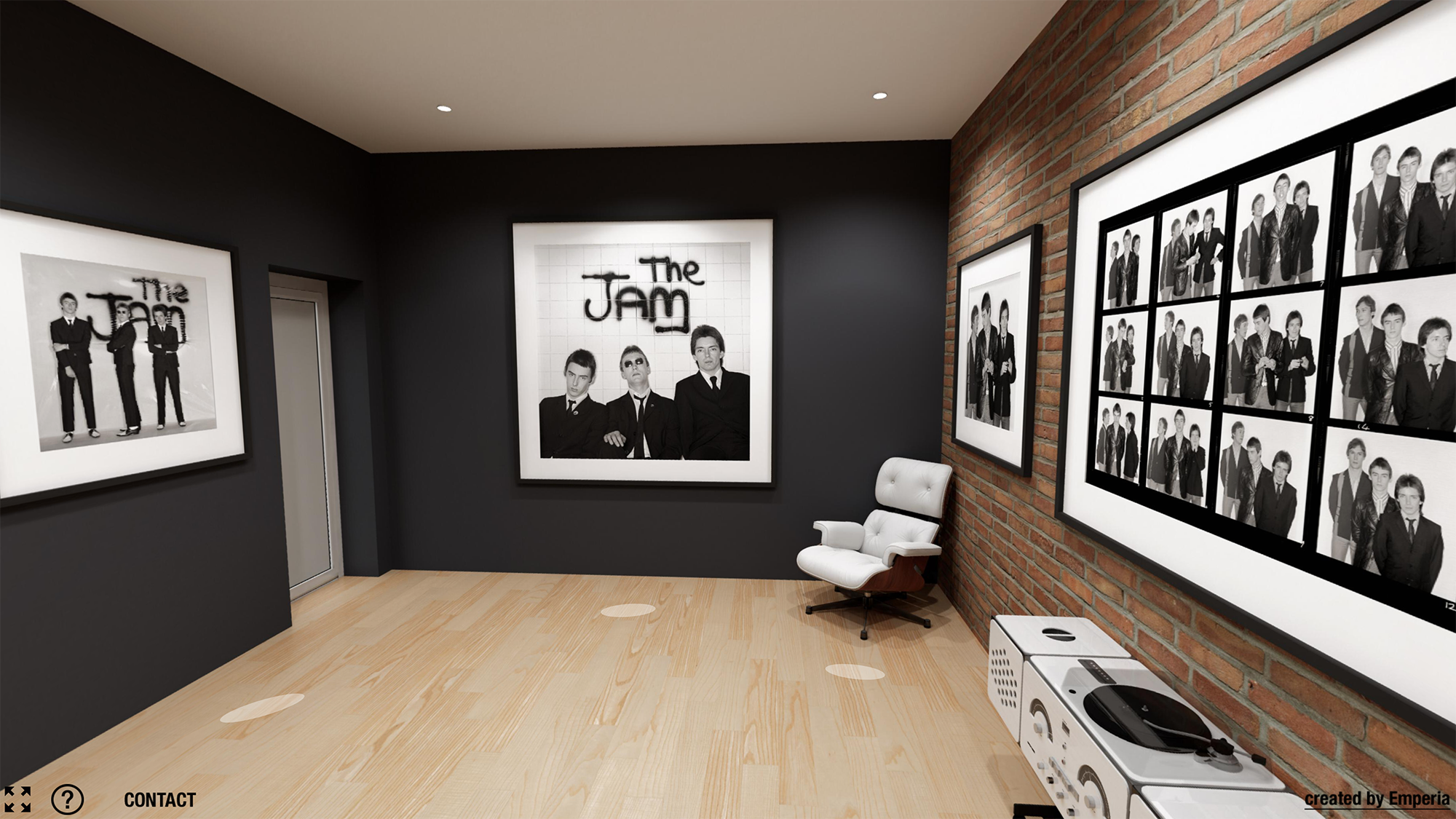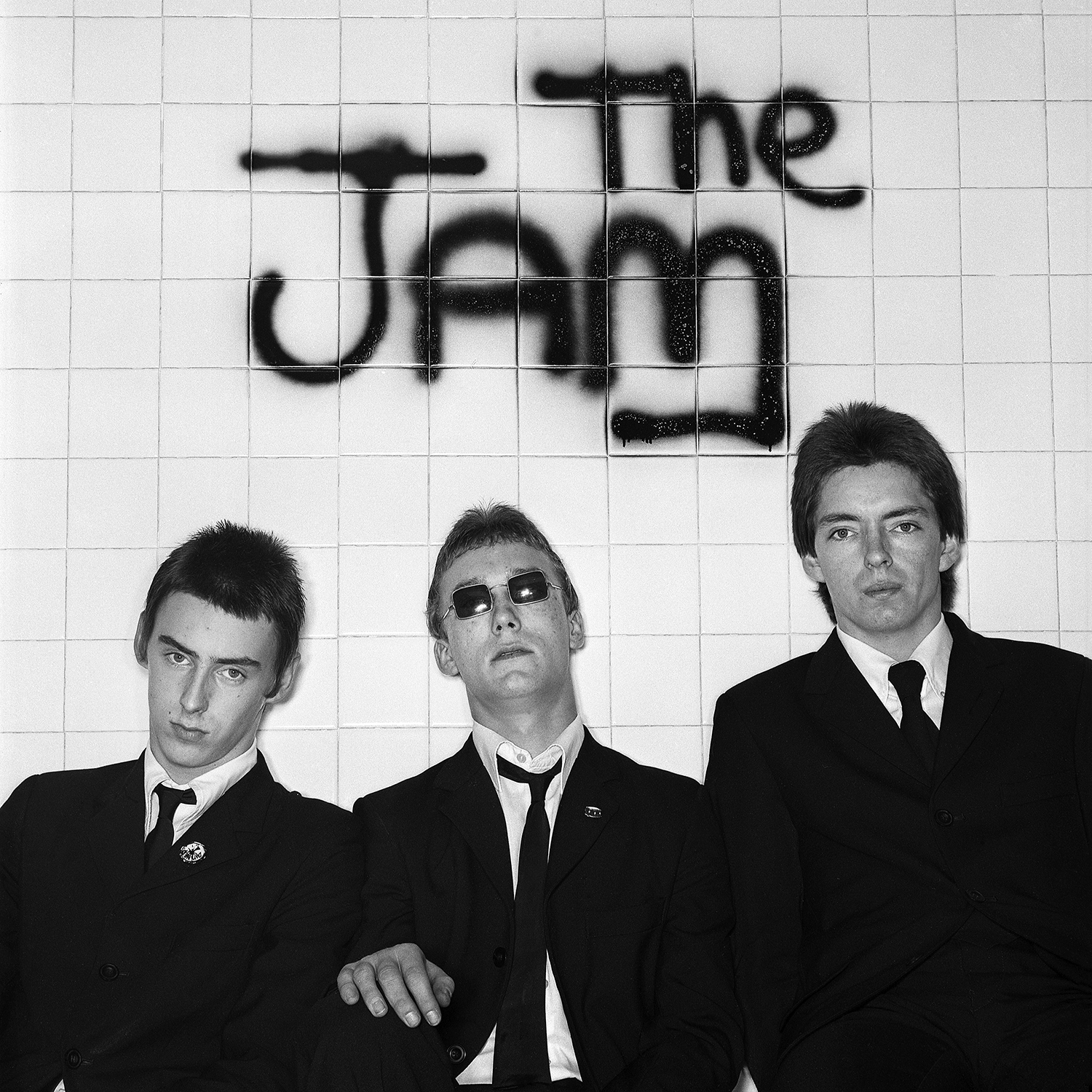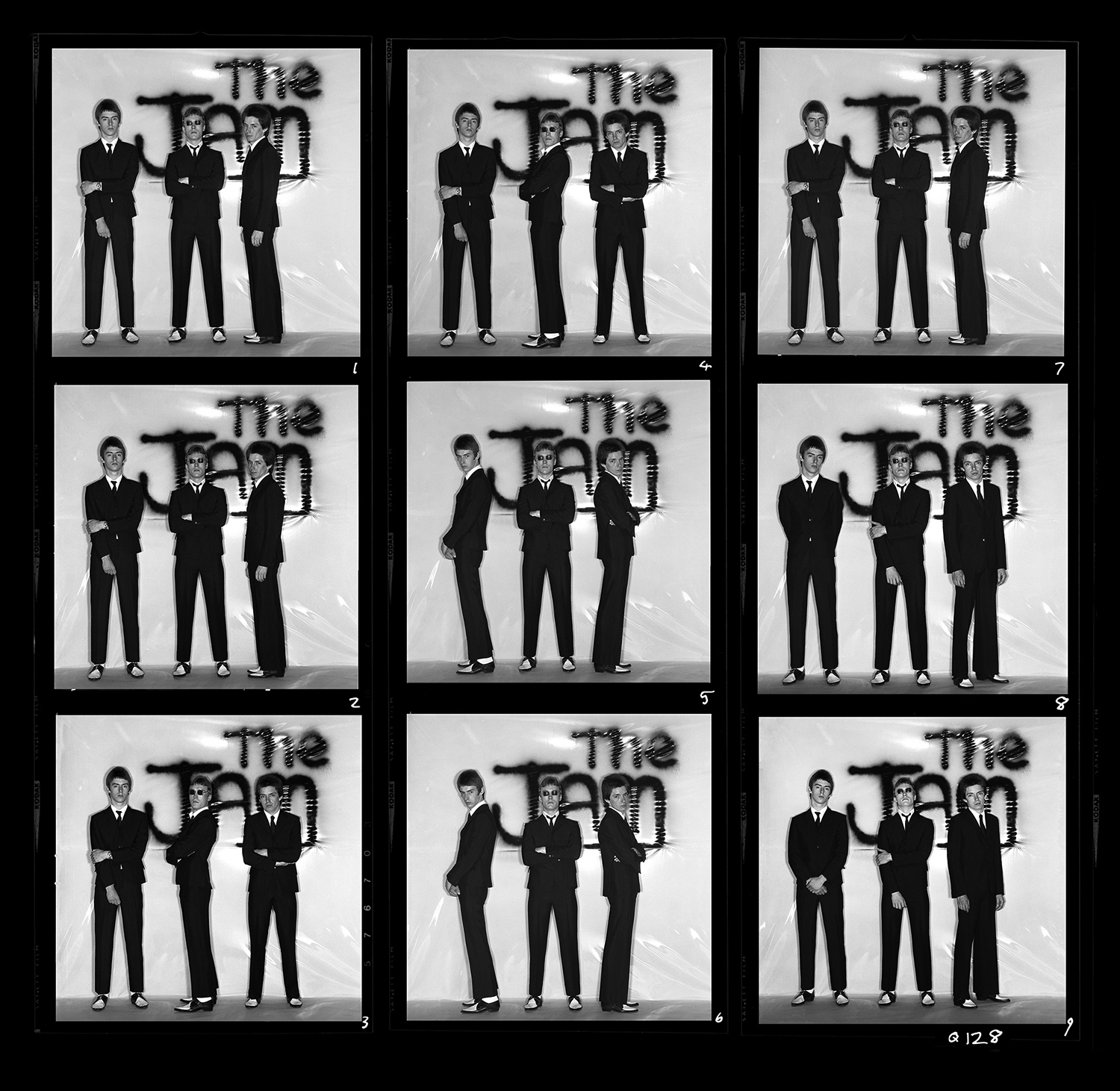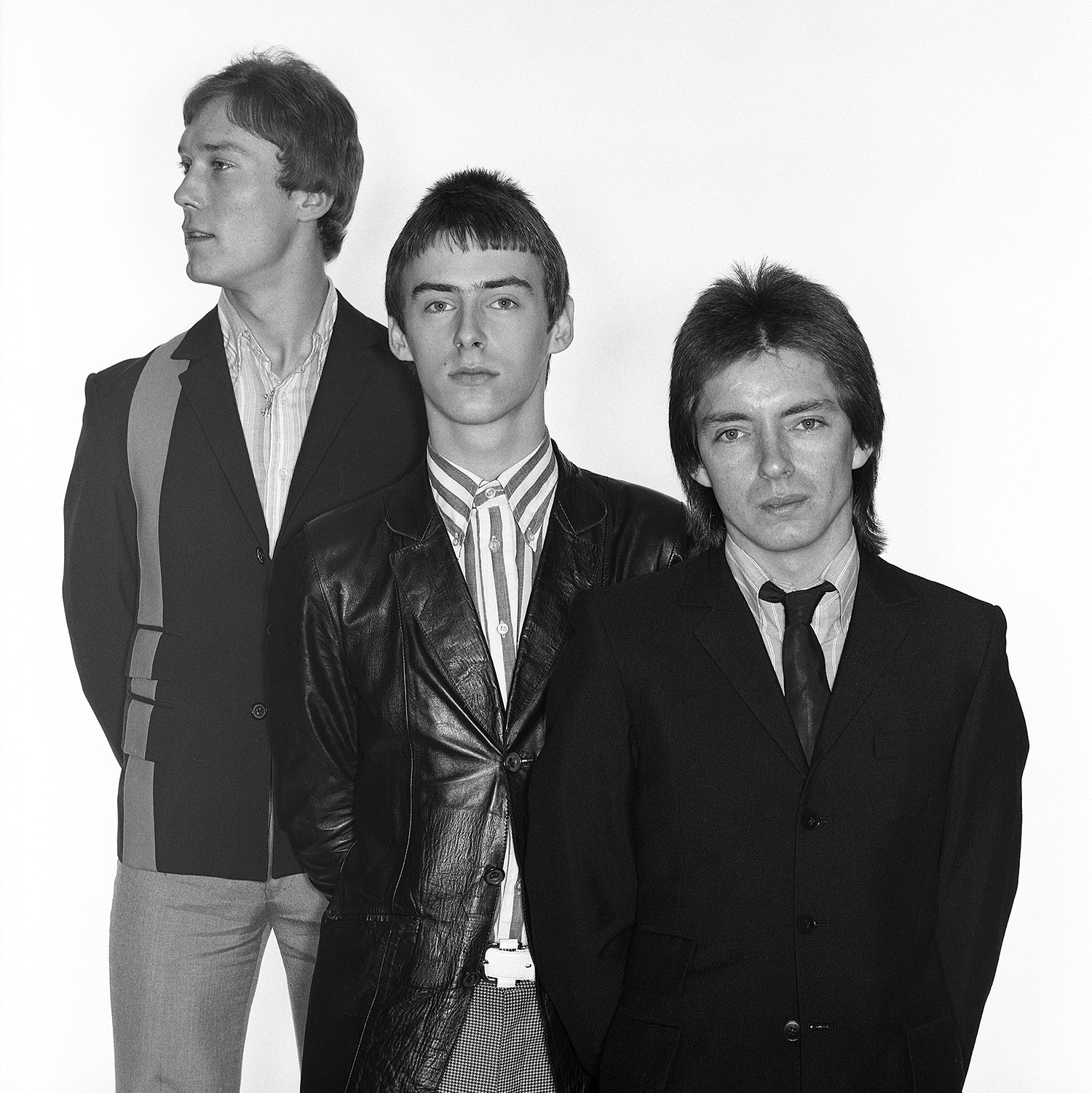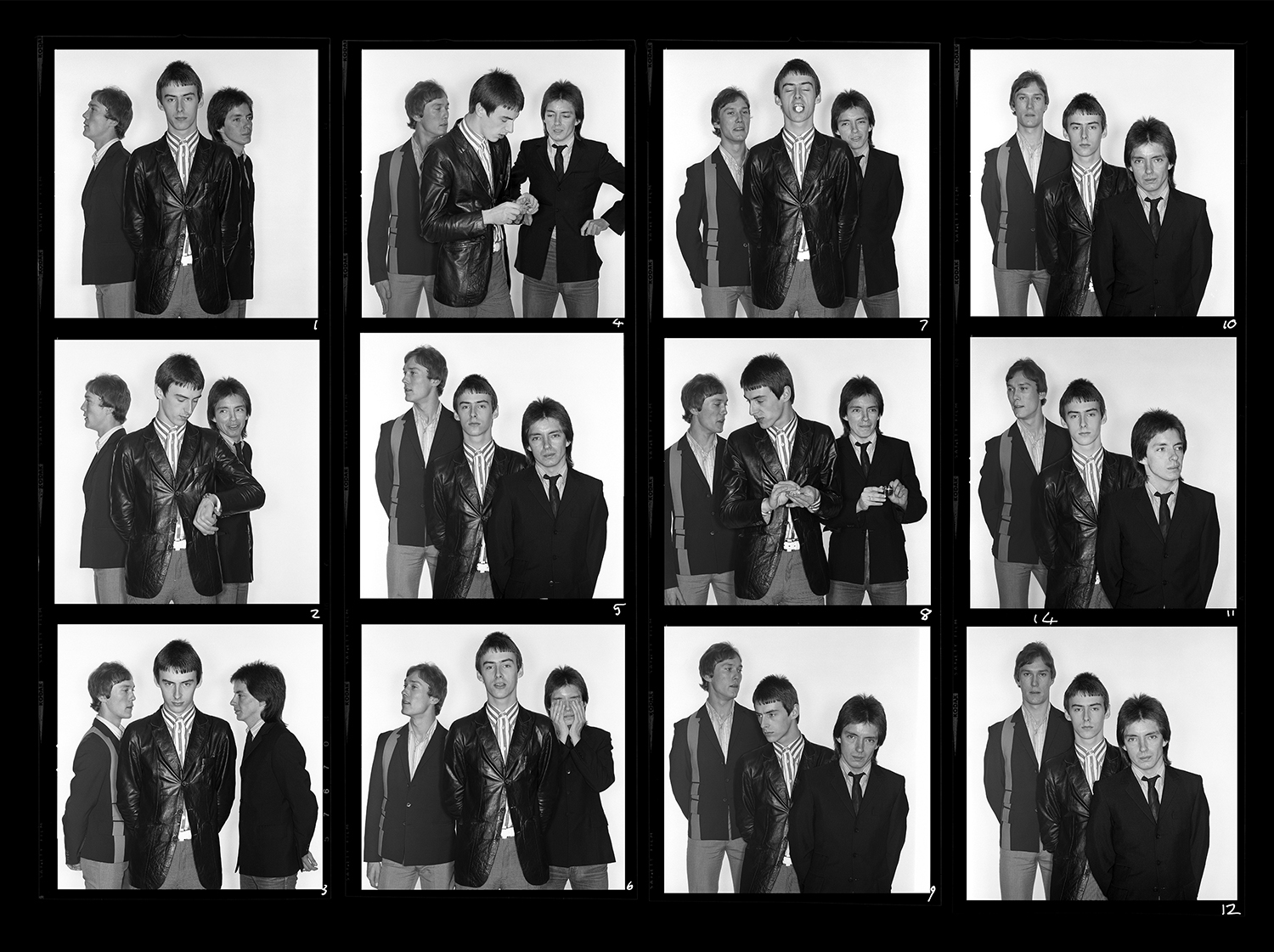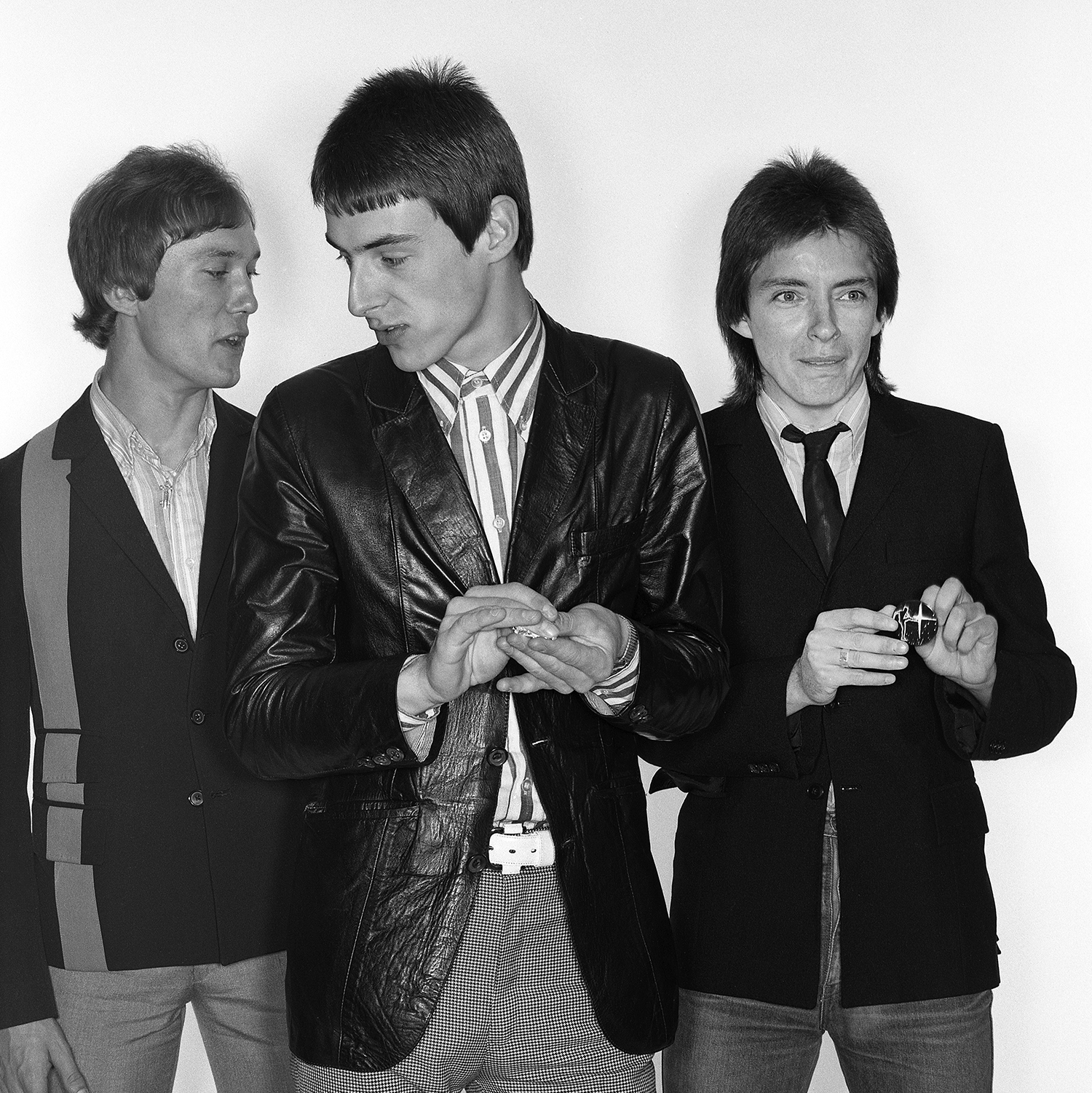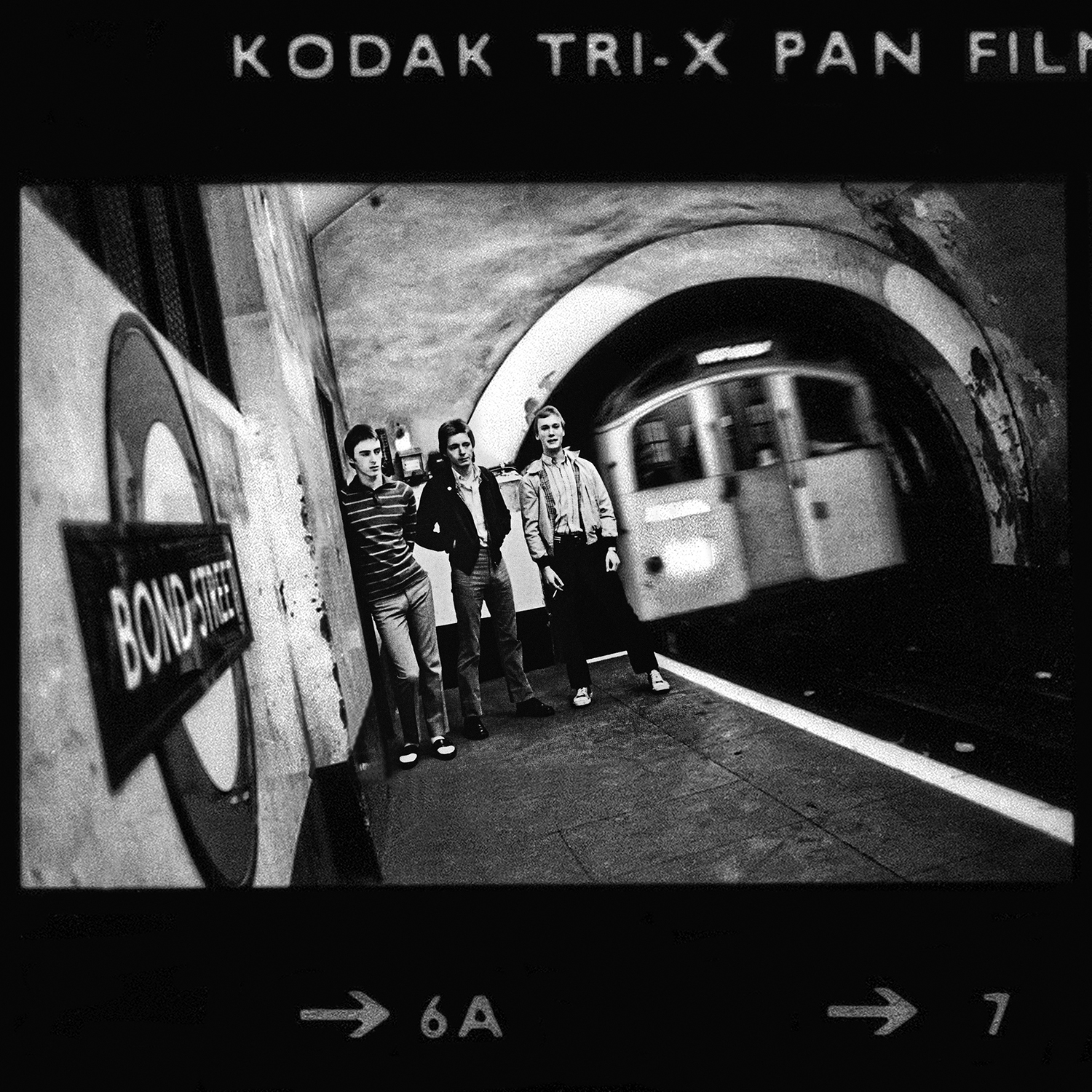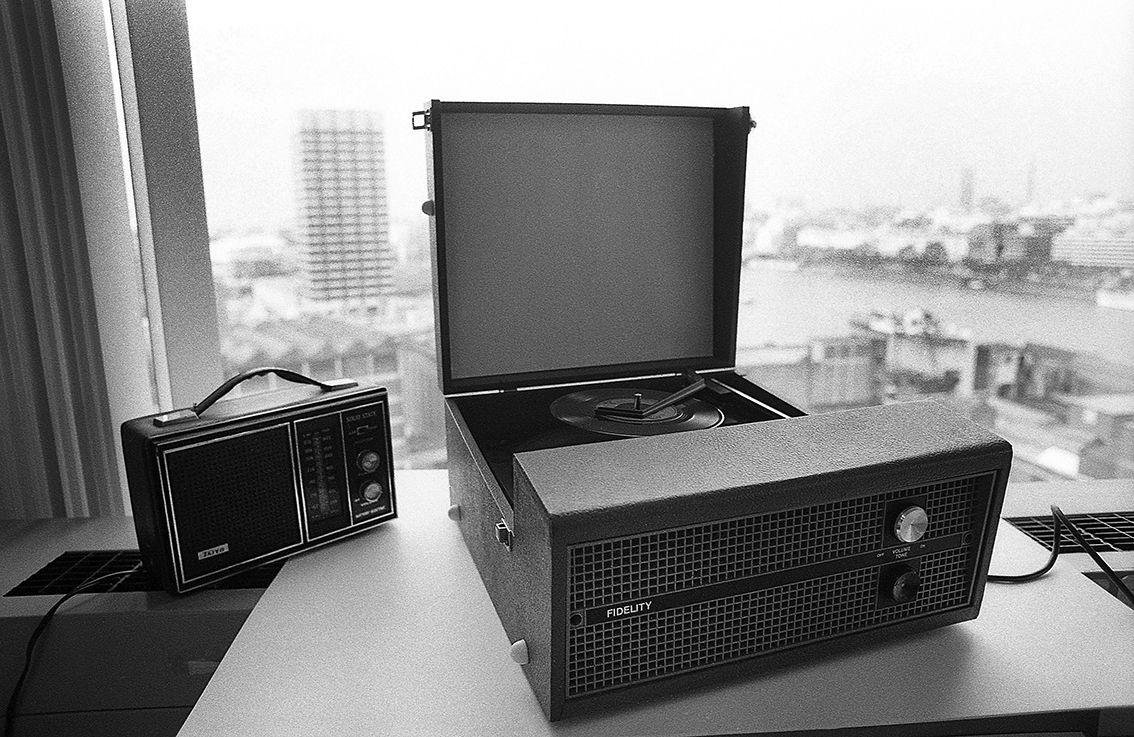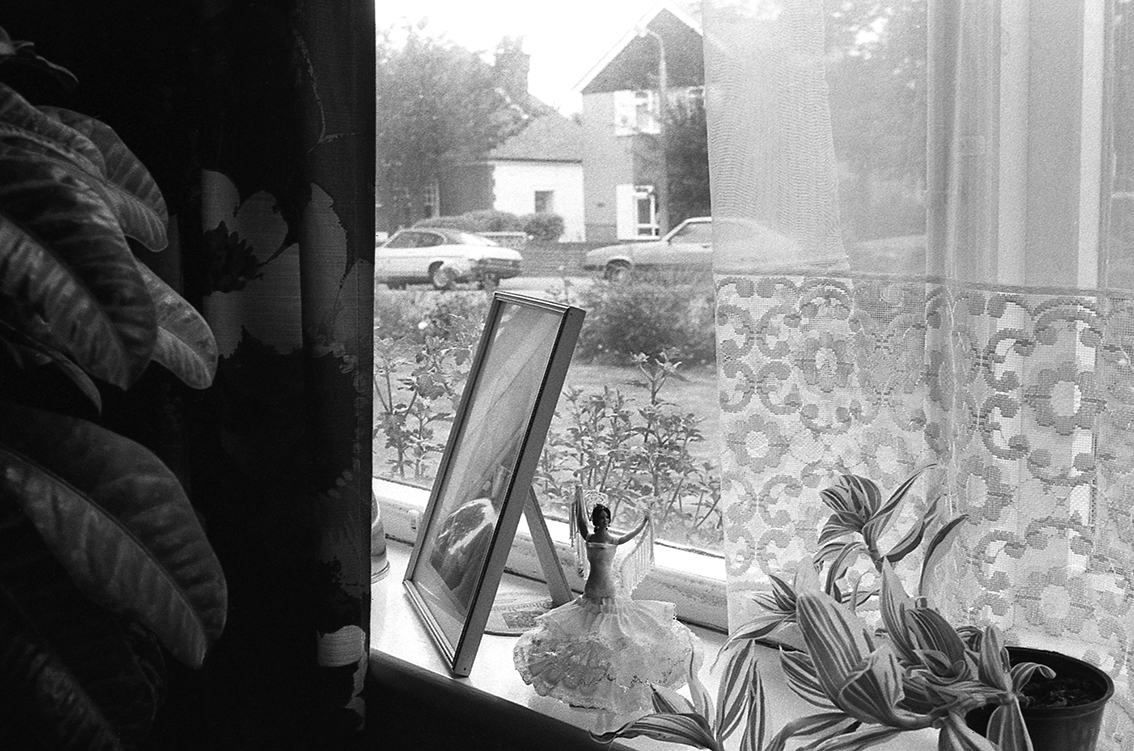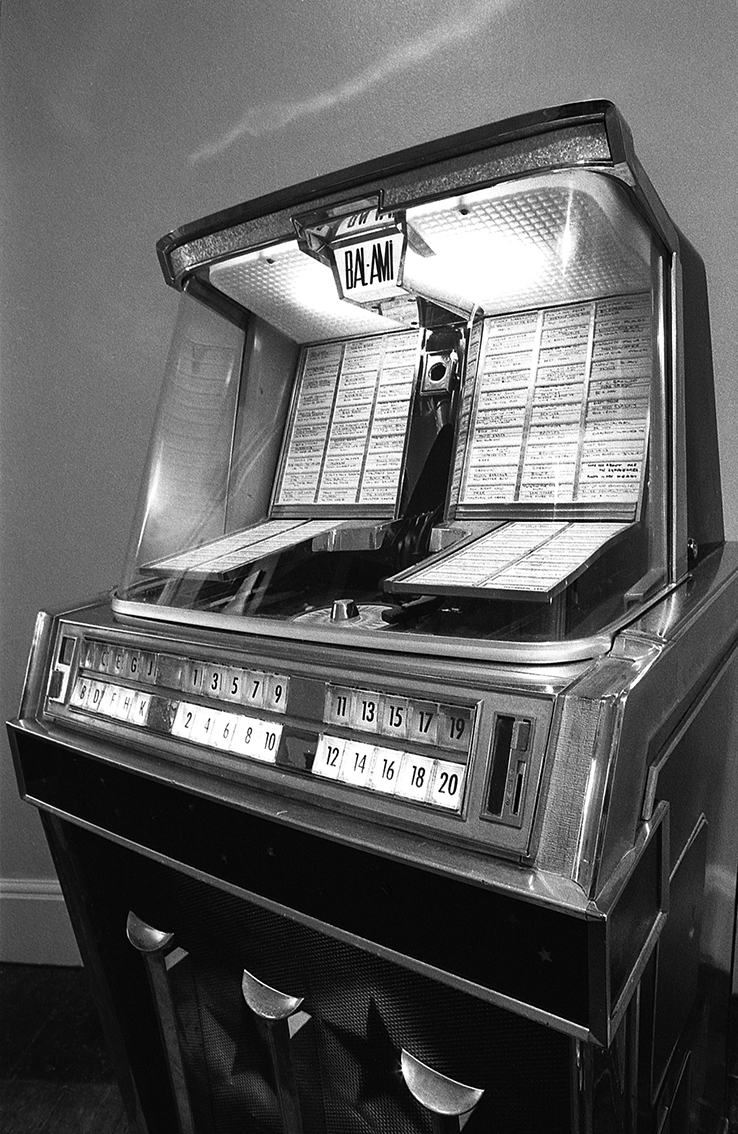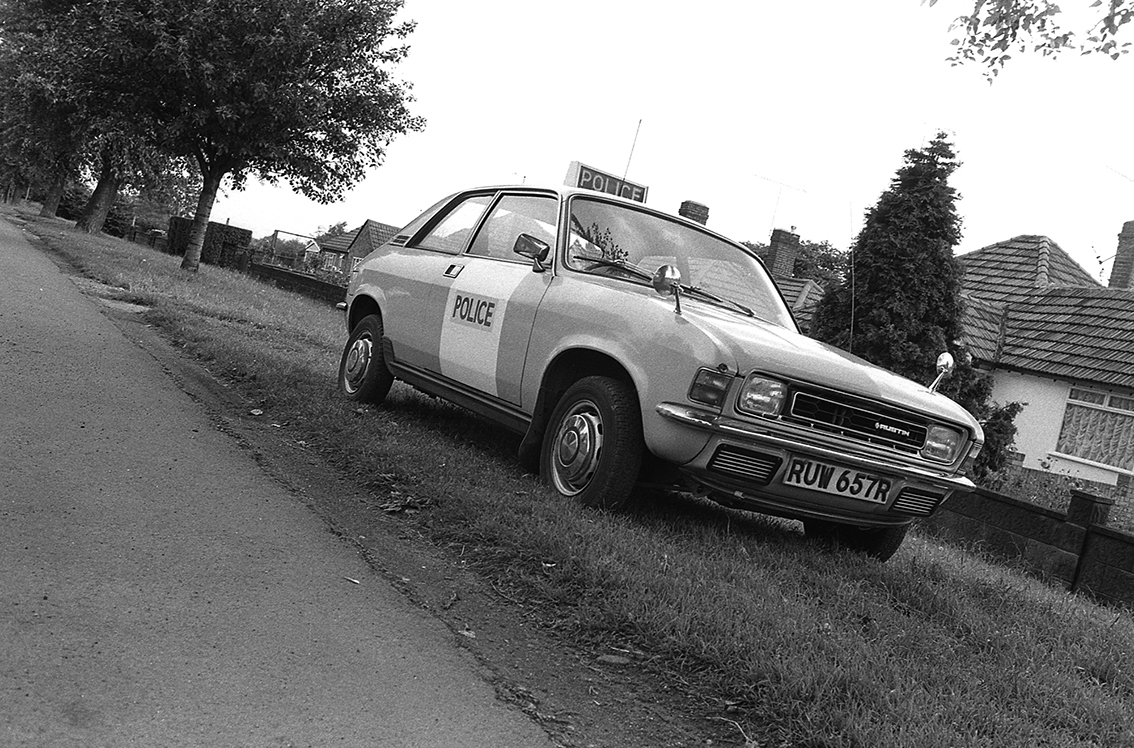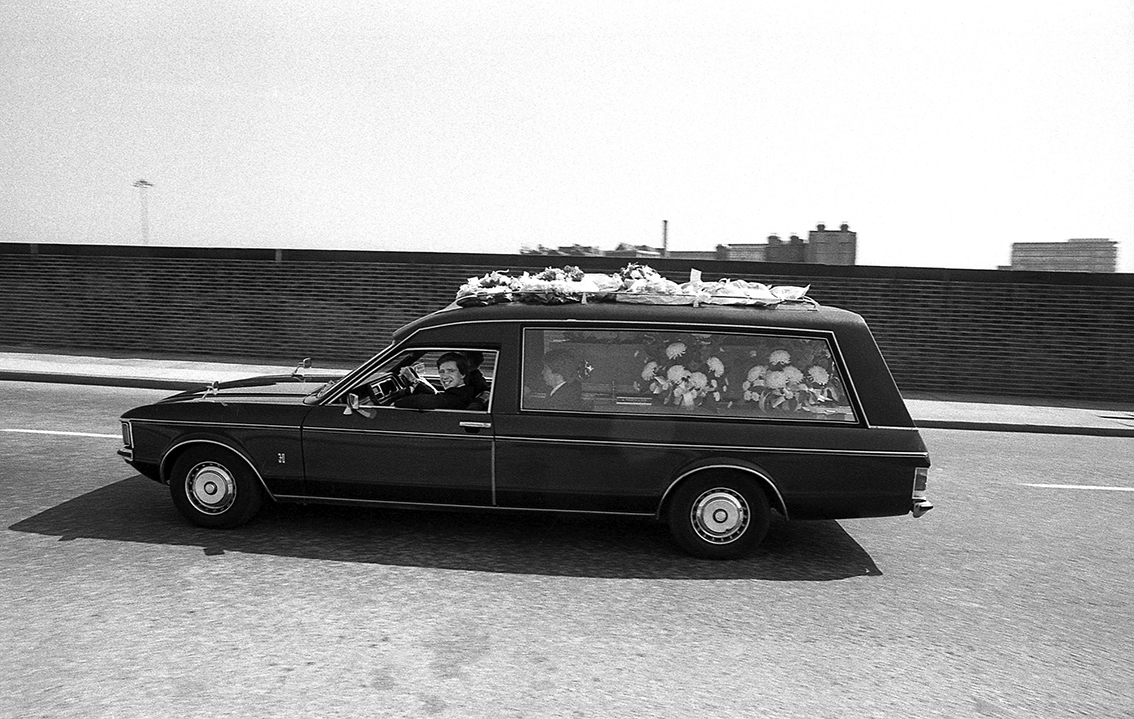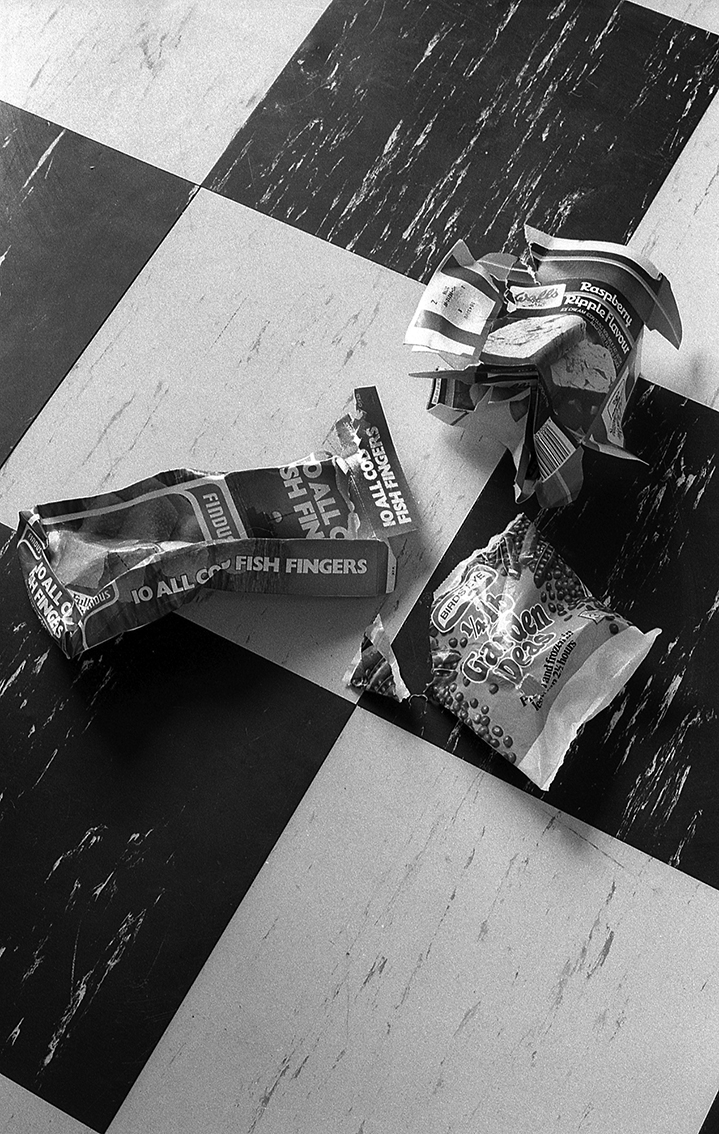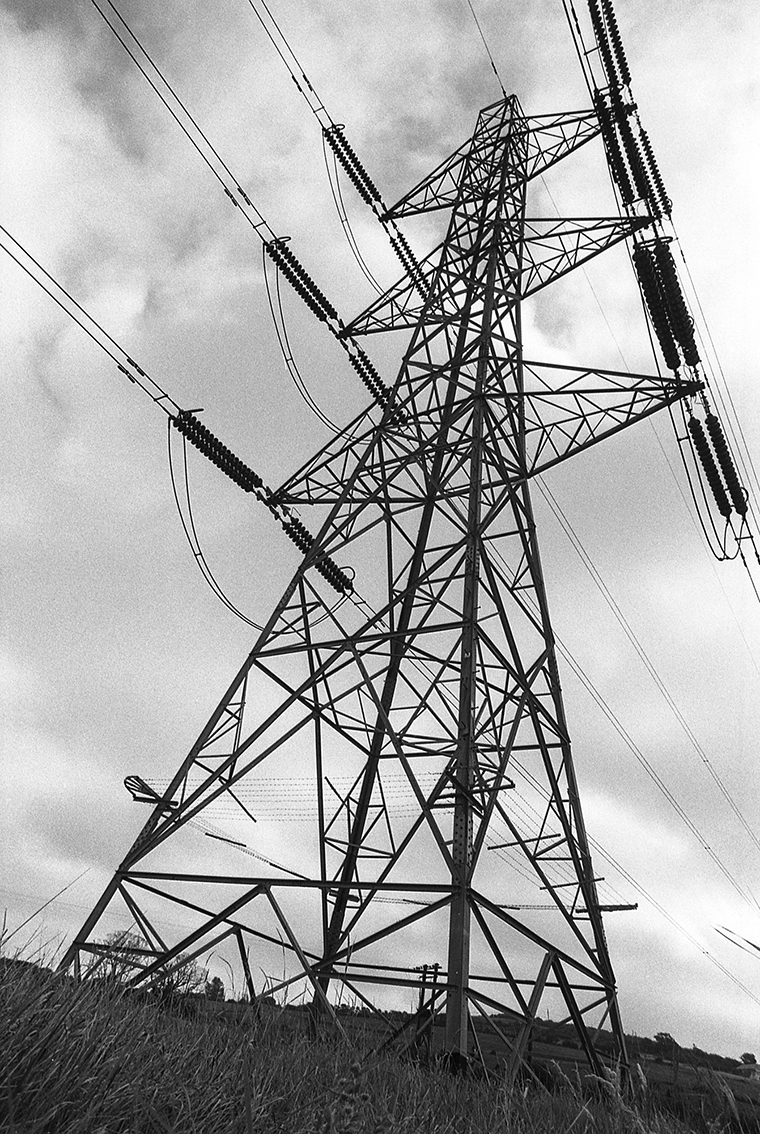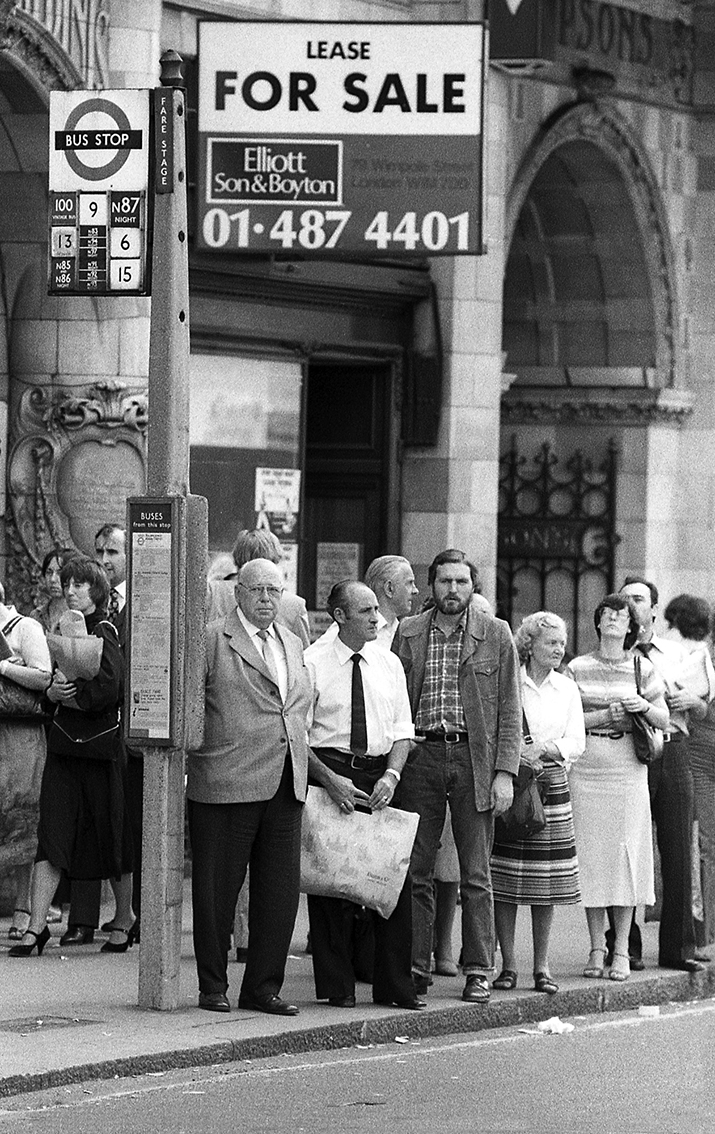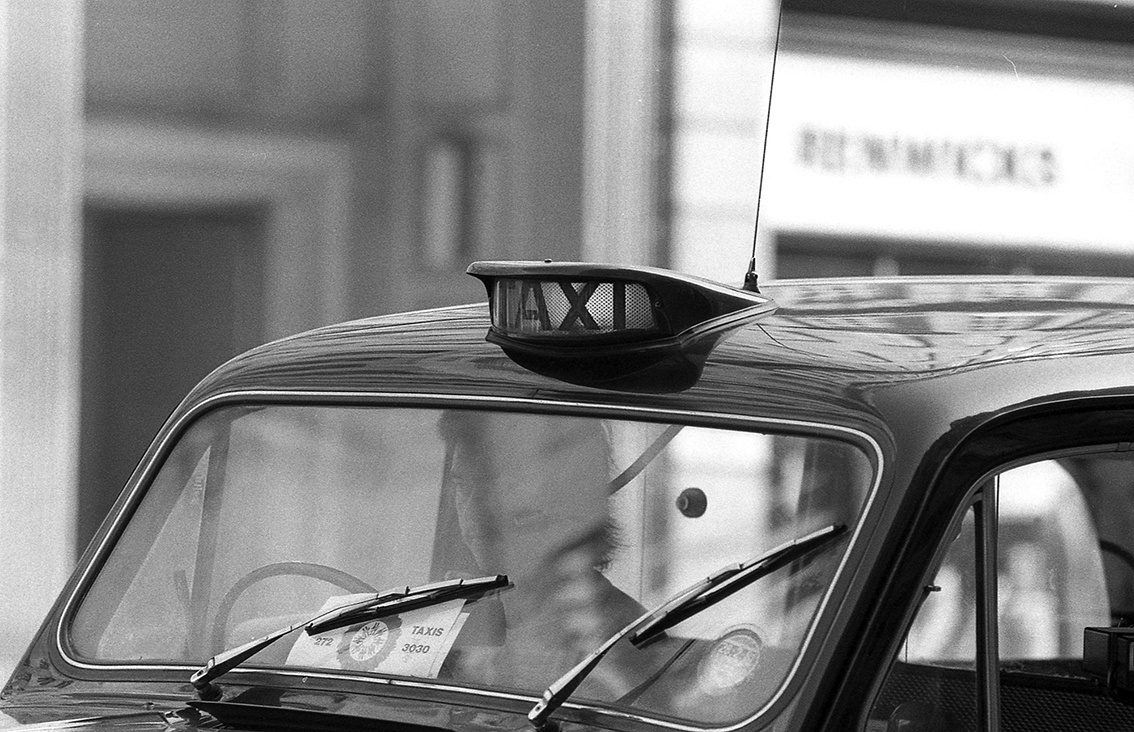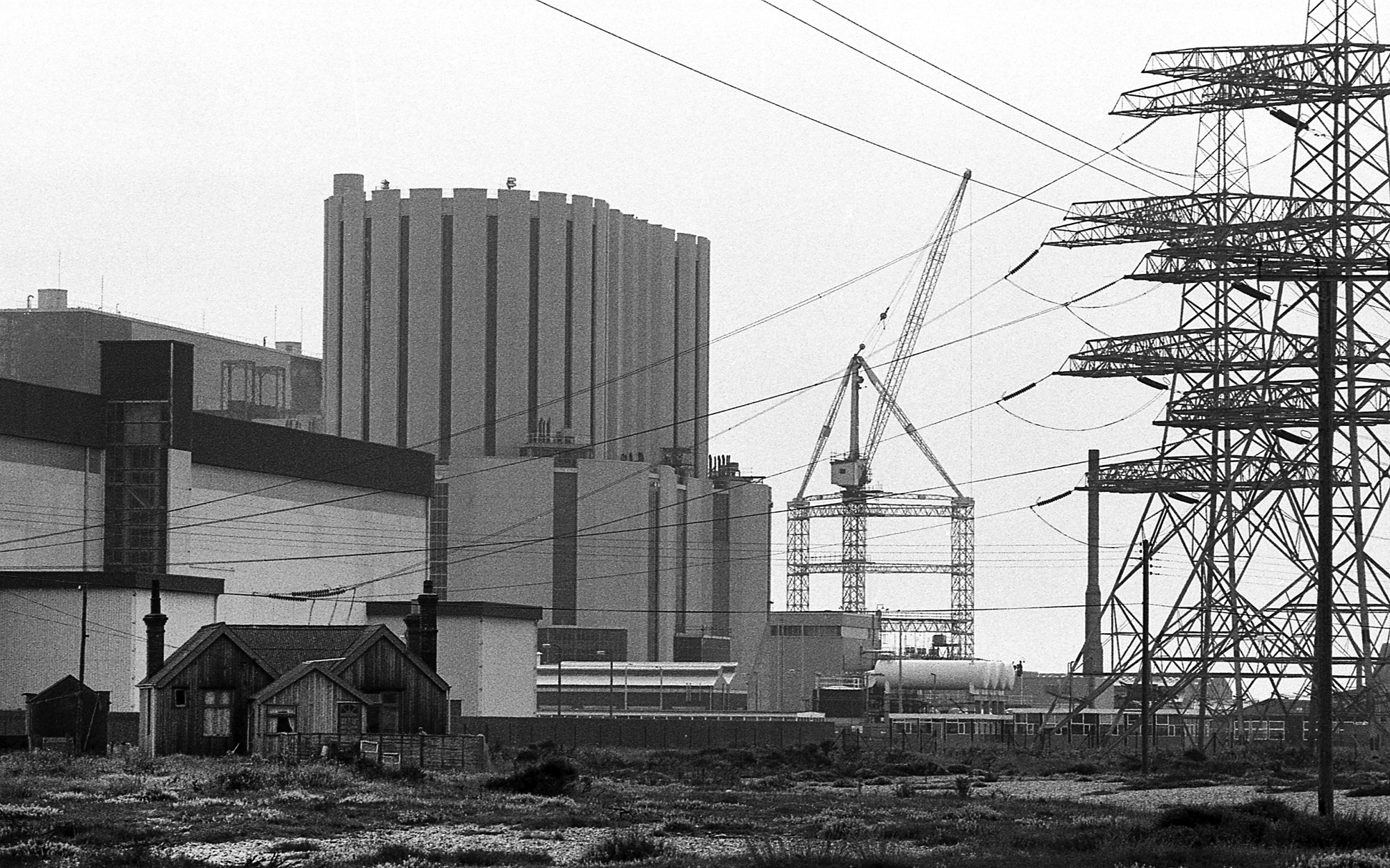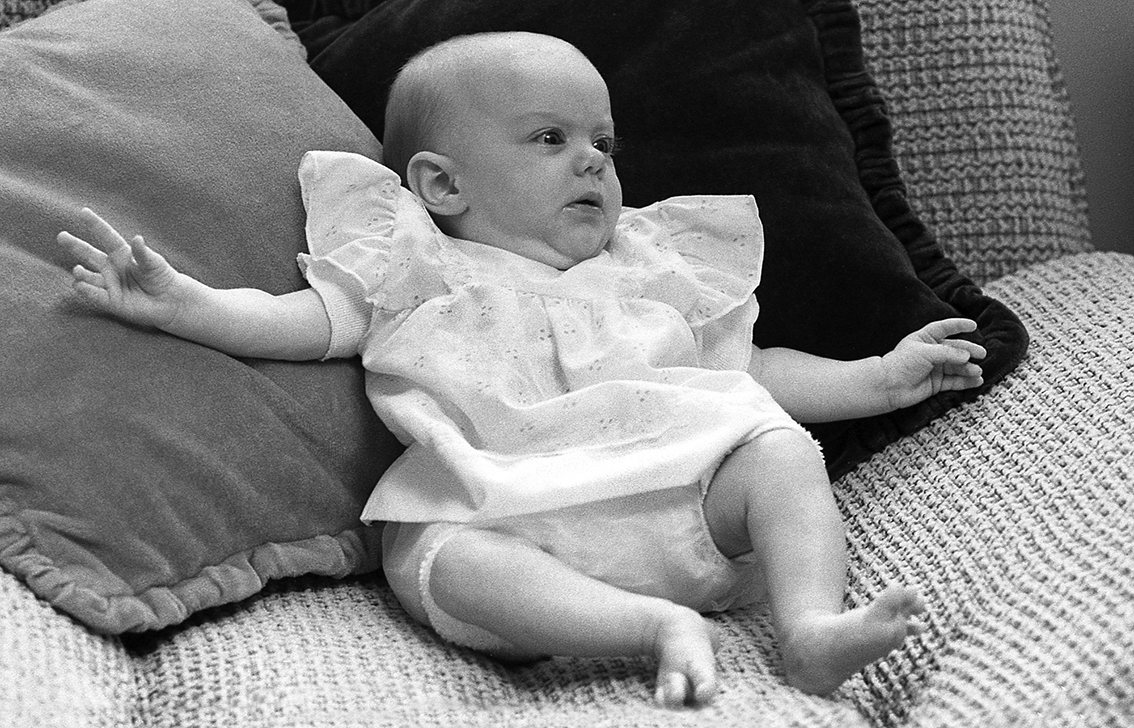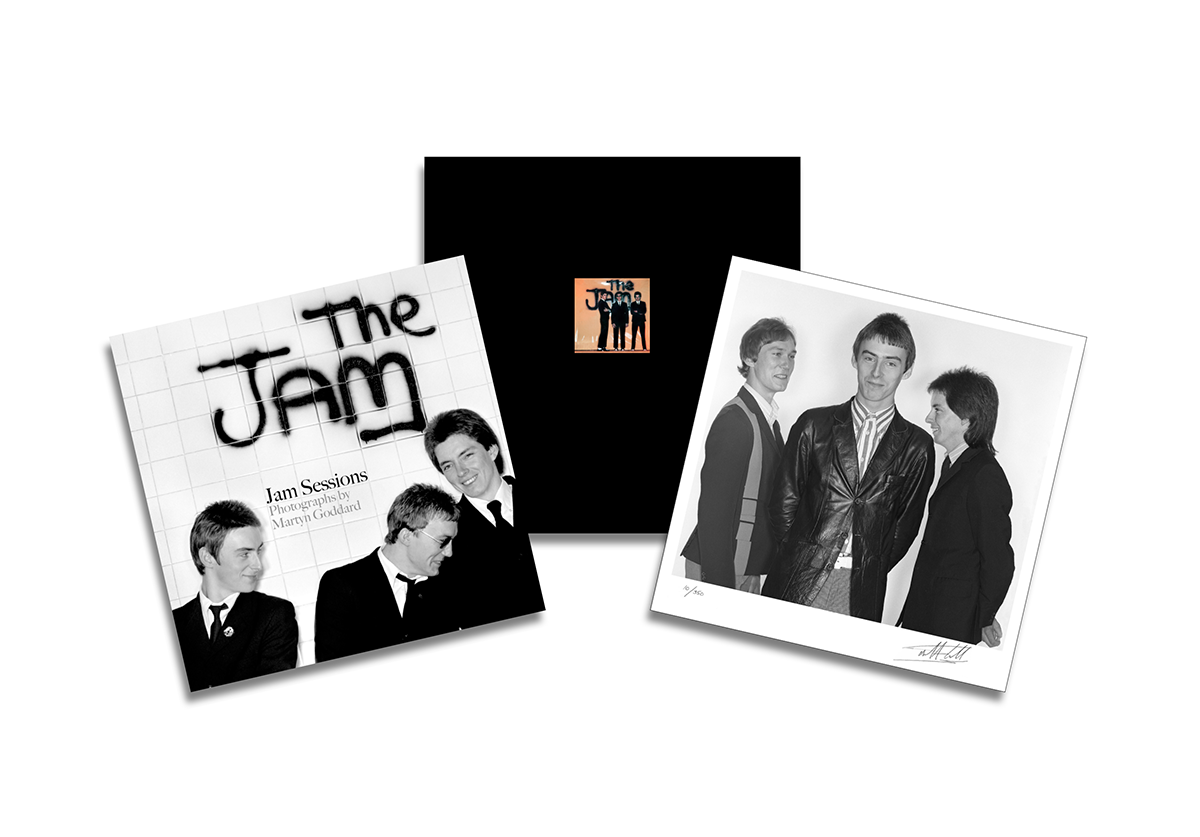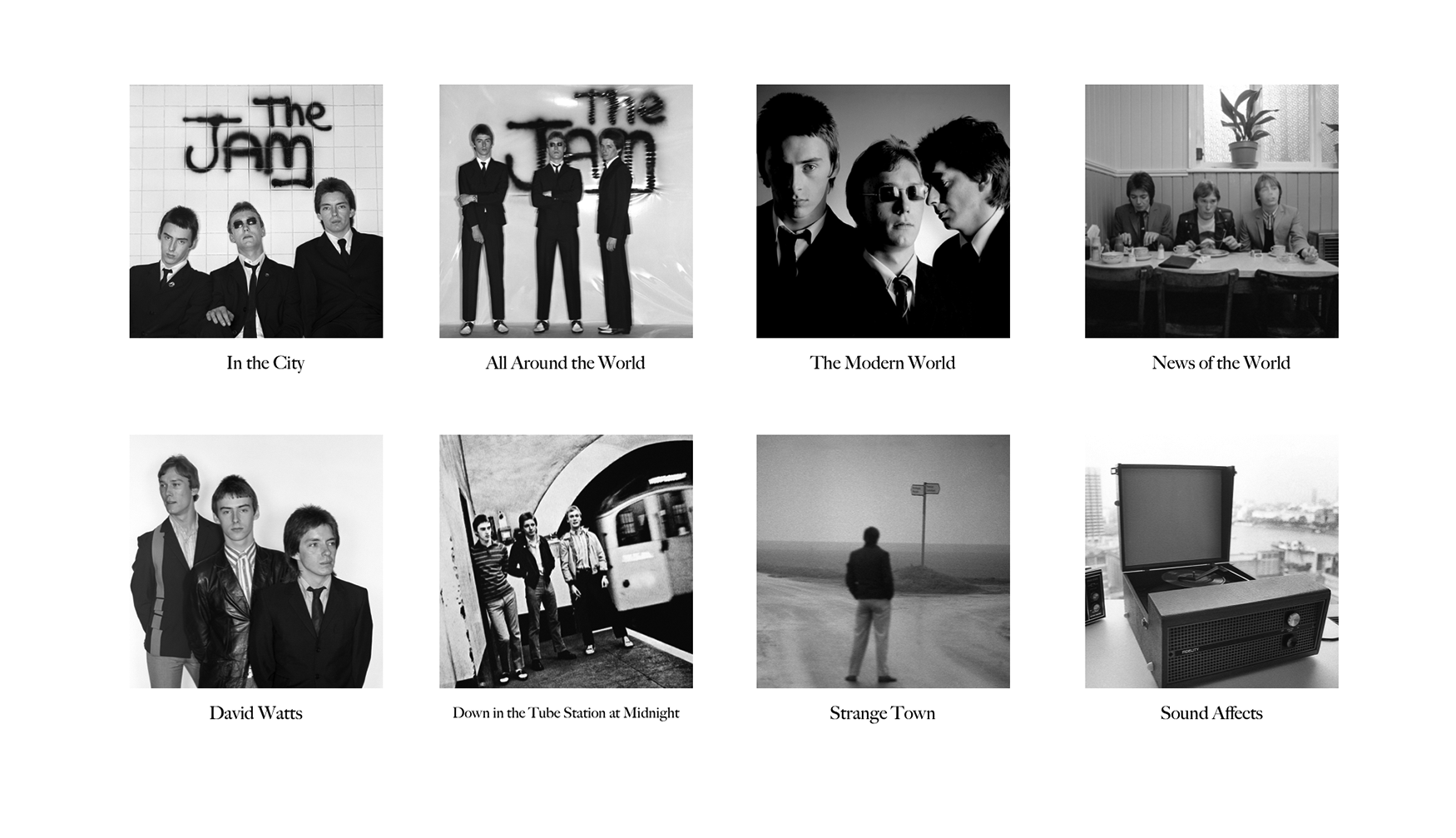Martyn Goddard
Photographs of The Jam
June 2021 marks the publication of Jam Sessions — Photographs by Martyn Goddard, the latest book from our imprint Ormond Yard Press. This is the definitive book of photographs from Martyn Goddard’s Jam archives, and is the first time that Martyn’s photographs of The Jam have been gathered together and presented in a single volume. Many of the photographs in this book were uncovered by Martyn during a comprehensive review of his archives during the Covid-19 lockdown, and are being published for the first time. You can read about the book in more detail below.
Alongside the publication of the book, Martyn has selected a number of images to offer as limited editions for the first time, in a choice of physical sizes. For many of these photographs, the negatives were long thought lost, or completely forgotten about and discovered during lockdown. For my money, the “All Around the World” session was one of the most important early shoots, as Martyn captured—for the first time— the three key defining elements of their early look: the suits, matching jam shoes and the classic logo sprayed freehand by Bill Smith. And of course that hair by Schumi. What a treat then, to be able to offer collectors the chance to acquire limited editions from this session for the first time. Other highlights include the full frame version of the “Down in the Tube Station at Midnight” cover image including the Bond Street tube sign, and photographs from the “David Watts” session, long thought lost, but now re-discovered and showing the band members having a great time together and clearly enjoying each others company. As Martyn points out, this was the first time Paul stood in the centre. Usually he would stand on the left in studio sessions, replicating his stage position—and his politics. Finally we present eleven of Martyn’s images from the Sound Affects LP cover, in their original uncropped format. These are fascinating slices of life in Britain at the dawn of the eighties. Check them out below.
Martyn Goddard’s signed limited edition photographs are available to purchase in a range of physical sizes. Scroll down the page to view the new collection. By clicking on the green button under each image you will see price and size options. Prices are shown for unframed items but we can arrange framing – please ask for a quote. We have also created a virtual space where you can view a small selection of Martyn’s photographs framed and hanging on the walls in a room setting. Please get in touch with us if you have any questions.
Visit the virtual viewing room
Click on the green button below to view our beautiful virtual viewing room featuring some of Martyn Goddard’s limited edition images, framed and on display.
This isn’t a replica of our physical gallery space—far from it. It is a room that we have designed from scratch and that only exists in the virtual world. You can navigate around the space easily, and click on individual artworks to view price and size information. It shows a selection, so do come back here to check out the rest.
The limited editions
In the City
Martyn recalls: “I had a phone call from Bill Smith in late February 1977. He had to produce an LP cover for a new band, which he was excited about—but as usual it was an urgent assignment as the record company wanted to release the album in May. The band was called The Jam, a three-piece outfit comprising Bruce Foxton on bass, Rick Buckler on drums and lead singer, songwriter and guitarist Paul Weller, who, to quote Bill, “is a bloke with definite ideas about the group’s image.”
At this point I hadn’t met any member of the band or seen a photograph. The album title was In The City and Bill’s concept for the cover was to photograph the group in an urban location against a wall of white tiles with a graffiti-sprayed logo. I could foresee a few problems doing this on location—because of the need to spray paint on a wall, and the permissions and permits that would be required. This first shoot would also take time, as we needed to produce front and back covers, and inner sleeve images. When Bill and I discussed the logistics, we decided to shoot in my studio in Kensington Church Street.
I can’t remember whether it was budget or time constraints but Bill and I spent the morning of the session—2 March 1977—covering two 8-foot by 4-foot flats with four-inch white crystal tiles. Then I witnessed a moment of magic, as Bill took the black spray paint and in one attempt produced the iconic Jam logo on the white ceramic tiles while the glue was setting.
All Around the World
The studio session for the band’s second single, “All Around the World”, took place in Martyn’s Kensington Church Street studio on 1 June 1977. It was an afternoon session – Paul Weller’s watch shows the time as 5.40pm. The band were wearing their signature black three-button suits, white button-down shirts and skinny black ties. On their feet they wore white socks and black and white “Jam” shoes. The plan was to keep the front cover simple: a full-length band shot with a vibrant yellow vinyl-covered background, sprayed with the now familiar Jam logo. Martyn added some dramatic effect by using fashion photography lighting.
The negatives from this classic early Jam shoot were thought lost, but were discovered by Martyn during the Covid-19 lockdown.
News of the World
The “News of the World” session took place on 9 February 1978, and was Martyn’s first shoot with the band outside the studio environment. Carnaby Street as a location made sense to everyone. It was central to the 1960s mod culture that Paul Weller was drinking in at the time, and Bruce Foxton had even penned a B-side titled “Carnaby Street” which appeared the back of their second single “All Around The World”.
Martyn recalls: “For the cover of “News of the World” the band wanted to continue the Carnaby Street theme so we met up in Soho early on a cold damp winter’s day. The plan was to shoot the group walking down the street towards the viewer—as if you were passing them in the street.”
“The shoot was necessarily short due to the cold outdoor location and the group members complaining at the early start and lack of breakfast. As luck would have it I knew the area well because my father-in-law ran a business in adjacent Beak Street and he was the fount of all knowledge when it came to local cafés. I led the way to Frank’s Café just around the corner in Lexington Street, where I shot one of the most informal and interesting rolls of 35mm film of the band. Paul sat on the right, again slightly separated from the others, having a cup of tea and a smoke, while Rick and Bruce tucked into a full English.”
David Watts / ‘A’ Bomb in Wardour Street
This was a studio session in Kensington Church Street on 24 May 1978. Martyn observes: “Looking back at the images from this session, the thing that really strikes me is how much fun they were all having. There’s a sense of them operating as a unit in these photographs, and enjoying each other’s company. This was also the first shoot where Paul was in the middle. Usually he stood on the left.”
This is another session where the negatives sat undiscovered in Martyn’s archives for over forty years, and are now being offered as limited editions for the first time.
Down in the Tube Station at Midnight
Martyn remembers: “For the “Down in the Tube Station at Midnight” single sleeve, we decided to shoot on location. We chose Bond Street tube station on the Central line, mainly, I think, because Bill Smith knew the station well as it was on his daily commute. The shoot took place on 12 September 1978. We waited until late evening before our raid on the station. This was going to be a quick one because we didn’t have permission. I used a 35mm Nikon camera with fast black and white film, pushed to the limit without a tripod, hence the resulting grainy images. The band stood at the end of the platform and I waited until a speeding train emerged out of the tunnel before pressing the shutter. We then made a hasty exit to street level.”
This is the first time Martyn has ever offered the full frame of the 35mm image, complete with Bond Street tube sign (cropped out for the single sleeve) and film rebates.
Sound Affects
A snapshot of British life.
Shooting still-life and street scenes for the Sound Affects cover was Martyn’s last assignment for The Jam. The photographs were all taken over a three day period at the end of July 1980, and represent a snapshot of life in Britain as the seventies turned into the eighties.
Martyn recalls: “It was an interesting assignment pulling together all the different elements required by the brief. Some of them were very close to home—I remember eating fish fingers, peas and raspberry ripple ice cream before crumpling up the empty packaging and photographing it on the floor of my kitchen. The juke box was mine—a 1960 BAL-AMi K200 model which I still own.
In London I took the photograph of the bus queue on the Strand, and the taxi was parked close to Euston station. The hearse was part of a funeral procession along York Way in Islington. The young funeral director smiling out of the passenger side window now runs the family business, which is still going, and is based in Lamb’s Conduit Street in Bloomsbury. Many years after taking the photograph I made him a print of the image. I shot the Fidelity record player in Bill Smith’s office overlooking the Thames.
The picture frame on the window sill was in my parents’ living room in Birchington-on-Sea in Kent. While I was there I photographed the Austin Allegro Panda police car, and the electricity pylon standing in a field. The nuclear power station was at Dungeness, on the Kent coast.
I am often asked about the baby. She was the daughter of a friend of my sister. We managed to track her down for the Jam exhibition at Somerset House in 2015, where she met the band.”
None of these photographs have been available to purchase before. Theyare available to purchase individually in a choice of sizes, or as a set of eleven photographs on 8 x 10 inch paper, each one signed and numbered by Martyn Goddard.
Sound Affects – a set of eleven limited edition photographs
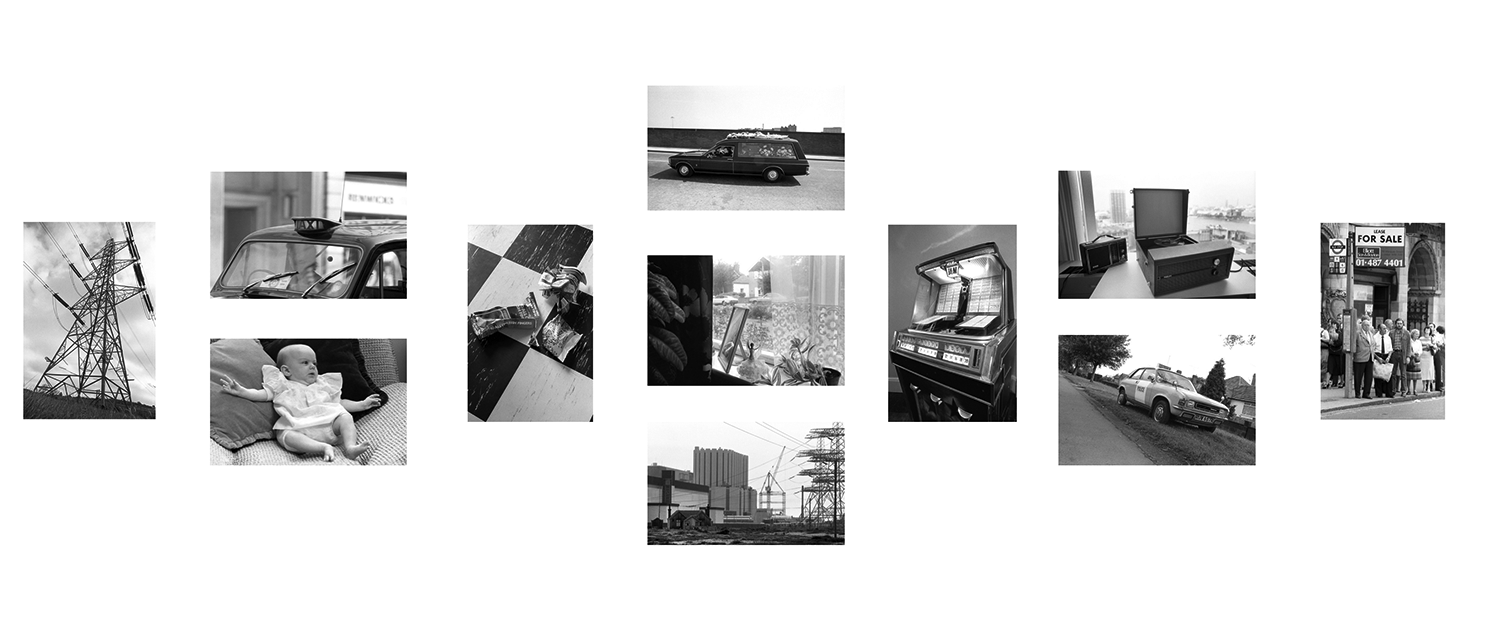
Jam Sessions: Photographs by Martyn Goddard
The new book from our publishing arm, Ormond Yard Press.
Jam Sessions
Photographs by Martyn Goddard
Published by Ormond Yard Press in June 2021.
Jam Sessions, with photographs by Martyn Goddard, is the latest book from our publishing arm, Ormond Yard Press, and features the very best work from Martyn Goddard’s extensive Jam archives.
This beautiful signed and numbered limited edition book measures 12 x 12 inches and contains approximately 150 photographs and personal recollections from Martyn’s eight sessions with the Jam from 1977 to 1980. Many of the photographs have never been published before.
The signed hardcover book is housed in its own presentation box and is accompanied by a signed and numbered 12 x 12 inch limited edition photograph of The Jam selected by Martyn Goddard.
The edition size is small – just 350 individually signed and numbered books are available to collectors worldwide.
More about the book
Jam Sessions — Photographs by Martyn Goddard is the definitive book of photographs from Martyn Goddard’s Jam archives. This is the first time that Martyn’s photographs of The Jam have been gathered together and presented in a single volume. Many of the photographs in this book were uncovered by Martyn during a comprehensive review of his archives during the Covid-19 lockdown, and are being published for the first time.
For avid consumers of Jam vinyl in the late seventies and early eighties, Martyn Goddard’s photographs need little introduction. His images appear on the cover of their first album, In The City, and their fifth, Sound Affects. In between, his photographs were used on the front covers of a flurry of picture sleeve singles: “All Around The World”,“The Modern World”, “News of The World”, “David Watts/ ‘A’ Bomb in Wardour Street”, “Down in the Tube Station at Midnight”, and finally “Strange Town”.
Jam Sessions presents the very best of his sessions with the band, supported by Martyn’s personal recollections, and his shoot journals, where he recorded the dates of his studio sessions. These journals provide a fascinating visual reference of the lighting set up and camera/ lenses he used, and also include some original polaroids taken by Martyn as part of the set up for the sessions. The polaroids are interesting historical documents, and while not capable of pin sharp enlargement because of their small original size (just 6 x 6 cm), they are an important part of the story.
For those growing up with the Jam, picture sleeves provided important visual references and studying them in detail was standard activity on release day. What was Paul Weller wearing? Where could you buy it? It all meant something when you were invested heavily in this band. By spending time with Martyn’s surviving archive, as presented in this book, we better appreciate his role in documenting the group’s image in this golden period marking their ascendancy on the UK music scene.
This is a limited edition hardcover book—just 350 individually signed and numbered copies are being offered to collectors worldwide. Each book is housed in a presentation box and is accompanied by a signed and numbered limited edition print of an image of The Jam from the David Watts cover session in 1978.
It has been a pleasure to work with Martyn on this book, and we hope you enjoy it.
“Most of the sessions with The Jam were held in my studio in Kensington Church Street, in West London. Bill Smith, who was the art director at Polydor Records looking after the Jam, would usually phone a few days before each shoot and I would make sure that I had the backgrounds and lighting equipment ready. My method of working at that time was to try and make the sessions quick and interesting, as young musicians often had a short attention threshold. It was up to me and Bill to know what we wanted to produce and then get on with it. With new wave bands, shoots rarely took all day.” Martyn Goddard.
Jam Sessions facts and figures
12 x 12 inch limited edition hardcover book, 84 pages on heavyweight 400gsm paper
Layflat presentation, so when open, double pages spreads lie completely flat and no images are lost in the central gutter
Approximately 150 photographs, many previously unpublished
A worldwide limited edition of 350 copies, each book signed and numbered by Martyn Goddard
Supplied with a limited edition 12 x 12 inch photograph, signed and numbered by Martyn Goddard
Book and photograph have matched edition numbers.
Book and photograph housed in black presentation box with inset image in lid.
No extra delivery costs for shipping to a UK mainland address.

The front cover of the book
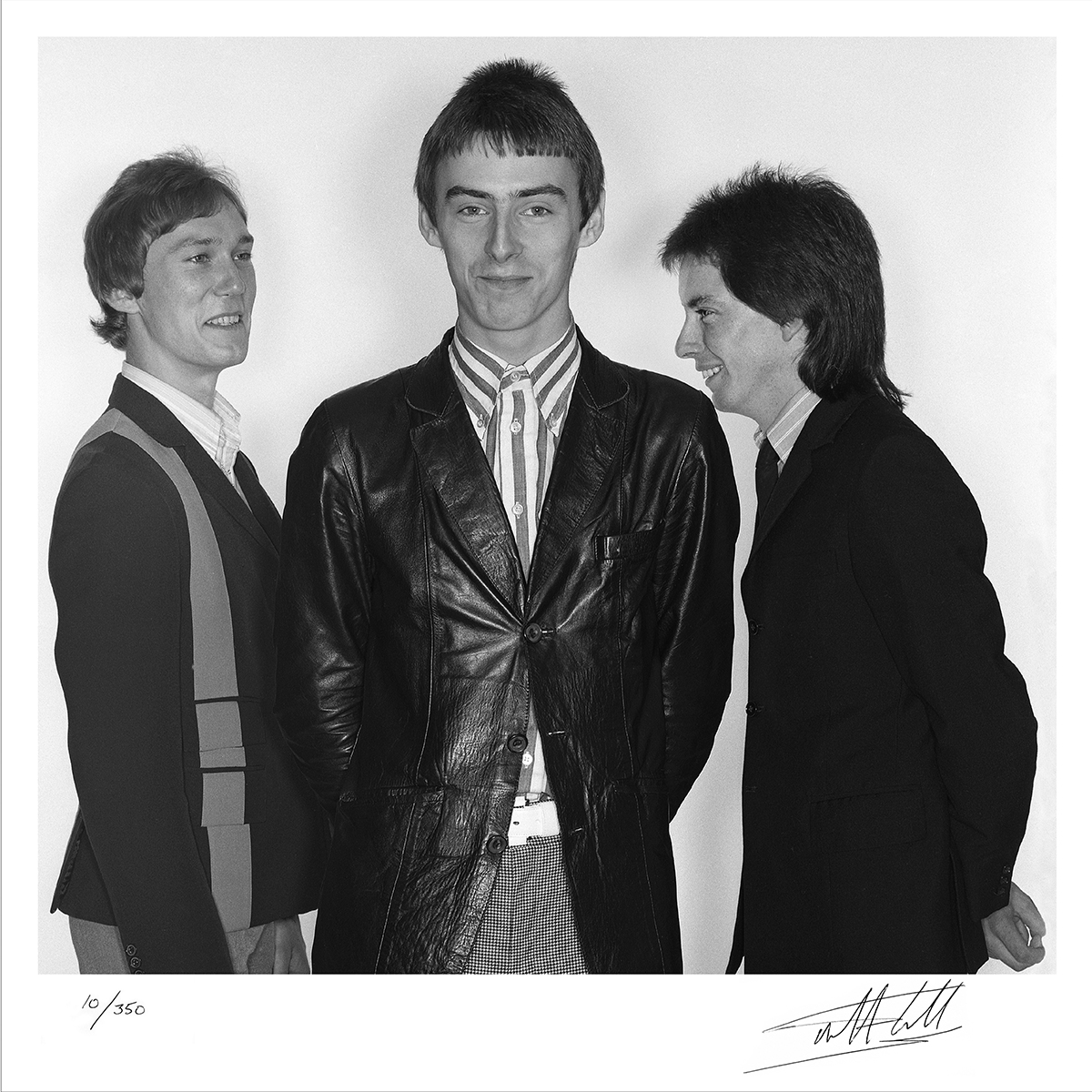
The limited edition photograph
The limited edition photograph
Each book is accompanied by a signed and numbered limited edition photograph, which is suitable for framing.
The photograph has an image size measuring 11 x 10 inches (approx 28 x 25 cm) on 12 x 12 inch (approx 30 x 30 cm) paper.
The image chosen by Martyn Goddard is a previously unpublished photograph from his studio session for the “David Watts” single sleeve, taken in his studio in Kensington.
Each archival photograph is signed and numbered by Martyn on the front under the image area.
The book and the print have matched edition numbers.
If you would like us to organise framing please get in touch.
Martyn Goddard
Martyn Goddard began taking photographs at school, building a darkroom in his parents’ bathroom. He went on to study photography at Harrow College of Art, where he refined his technique and, as he puts it “learned how to take pictures”. After graduating in 1974 he assisted various leading photographers, including renowned music photographer Gered Mankowitz, before going freelance.
He became part of the new wave music scene of the late-seventies, shooting artists such as Blondie, The Jam, Sham 69, Ian Dury and The Cure. He went on to work with more mainstream acts such as Genesis, Queen, Wham! (touring China with them) Elton John and U2. Towards the end of the seventies he was invited to contribute to The Sunday Telegraph Magazine where he was assigned portrait and feature shoots with some of the great writers, artists, actors and politicians. At the same time he was also contributing to the iconic Car magazine, producing automotive and travel stories. In recent years he has moved to a digital platform, becoming an active photo-blogger and content provider, producing travel features and images for media groups in the UK, Europe and USA, in addition to cataloguing and preserving his extensive archive of musicians.
He has contributed to or staged several photography exhibitions including Blondie in Camera in 1978 and The Jam About the Young Idea in 2015. He has published two book combining his images of musicians and motors, Rock ‘n’ Roll and Fast Cars, (Volumes 1 and 2). As Martyn explains: “As a freelancer I have always had the freedom to work for an array of interesting magazines and record labels. It has been an extension of my teenage dreams of music and fast cars that my chosen profession has given me the ability to be a part of both worlds, as I can’t play a note of music and only managed fourth place in my ten-year career as a historic rally driver.”
His collaborator on the Jam sessions that are featured in this book, Bill Smith, said “Martyn has always been terrific to work with, and after the first Jam session we worked on many, many album and single covers together—very successfully in my opinion. In a strange way we complemented each other in our working styles. His work is testament to his vigilant eye for detail and meticulous preparations. Too many people think photography is just clicking the shutter and hoping for the best. Martyn belies this notion, which is why he is still working all these years later.”
In recognition of his work, Martyn became a Fellow of the British Institute of Professional Photography in 1987.
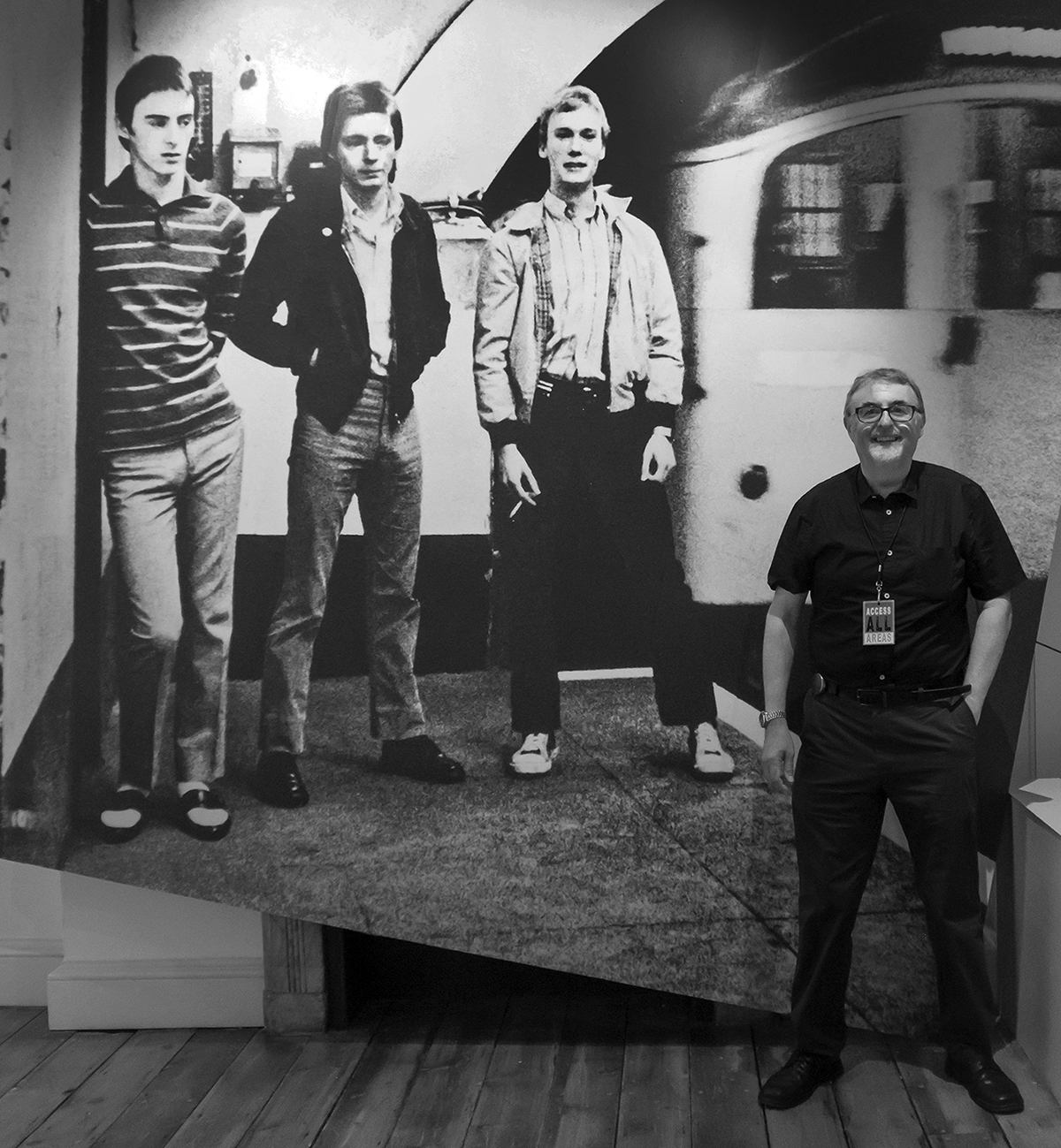
Martyn Goddard
